Jinhyuk Lee
On the Theoretical Limitations of Embedding-Based Retrieval
Aug 28, 2025Abstract:Vector embeddings have been tasked with an ever-increasing set of retrieval tasks over the years, with a nascent rise in using them for reasoning, instruction-following, coding, and more. These new benchmarks push embeddings to work for any query and any notion of relevance that could be given. While prior works have pointed out theoretical limitations of vector embeddings, there is a common assumption that these difficulties are exclusively due to unrealistic queries, and those that are not can be overcome with better training data and larger models. In this work, we demonstrate that we may encounter these theoretical limitations in realistic settings with extremely simple queries. We connect known results in learning theory, showing that the number of top-k subsets of documents capable of being returned as the result of some query is limited by the dimension of the embedding. We empirically show that this holds true even if we restrict to k=2, and directly optimize on the test set with free parameterized embeddings. We then create a realistic dataset called LIMIT that stress tests models based on these theoretical results, and observe that even state-of-the-art models fail on this dataset despite the simple nature of the task. Our work shows the limits of embedding models under the existing single vector paradigm and calls for future research to develop methods that can resolve this fundamental limitation.
Gemini Embedding: Generalizable Embeddings from Gemini
Mar 10, 2025Abstract:In this report, we introduce Gemini Embedding, a state-of-the-art embedding model leveraging the power of Gemini, Google's most capable large language model. Capitalizing on Gemini's inherent multilingual and code understanding capabilities, Gemini Embedding produces highly generalizable embeddings for text spanning numerous languages and textual modalities. The representations generated by Gemini Embedding can be precomputed and applied to a variety of downstream tasks including classification, similarity, clustering, ranking, and retrieval. Evaluated on the Massive Multilingual Text Embedding Benchmark (MMTEB), which includes over one hundred tasks across 250+ languages, Gemini Embedding substantially outperforms prior state-of-the-art models, demonstrating considerable improvements in embedding quality. Achieving state-of-the-art performance across MMTEB's multilingual, English, and code benchmarks, our unified model demonstrates strong capabilities across a broad selection of tasks and surpasses specialized domain-specific models.
Can Long-Context Language Models Subsume Retrieval, RAG, SQL, and More?
Jun 19, 2024


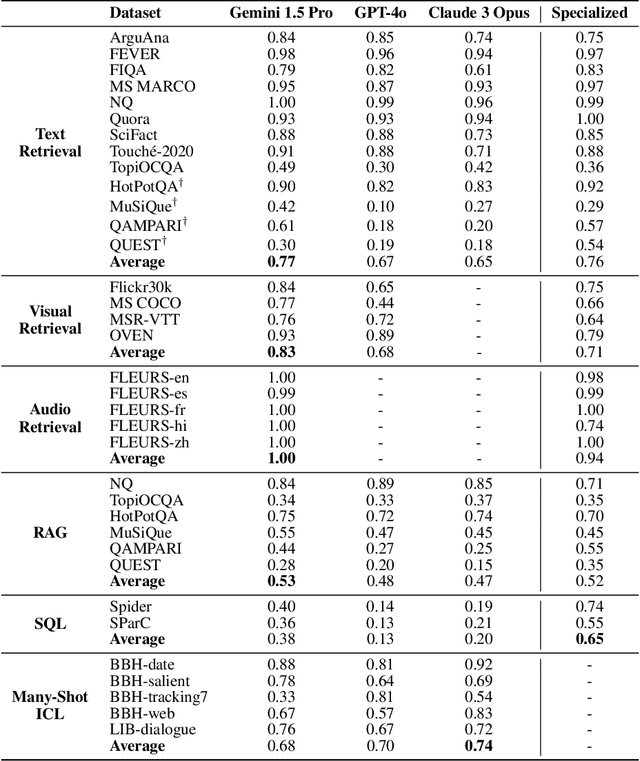
Abstract:Long-context language models (LCLMs) have the potential to revolutionize our approach to tasks traditionally reliant on external tools like retrieval systems or databases. Leveraging LCLMs' ability to natively ingest and process entire corpora of information offers numerous advantages. It enhances user-friendliness by eliminating the need for specialized knowledge of tools, provides robust end-to-end modeling that minimizes cascading errors in complex pipelines, and allows for the application of sophisticated prompting techniques across the entire system. To assess this paradigm shift, we introduce LOFT, a benchmark of real-world tasks requiring context up to millions of tokens designed to evaluate LCLMs' performance on in-context retrieval and reasoning. Our findings reveal LCLMs' surprising ability to rival state-of-the-art retrieval and RAG systems, despite never having been explicitly trained for these tasks. However, LCLMs still face challenges in areas like compositional reasoning that are required in SQL-like tasks. Notably, prompting strategies significantly influence performance, emphasizing the need for continued research as context lengths grow. Overall, LOFT provides a rigorous testing ground for LCLMs, showcasing their potential to supplant existing paradigms and tackle novel tasks as model capabilities scale.
Gecko: Versatile Text Embeddings Distilled from Large Language Models
Mar 29, 2024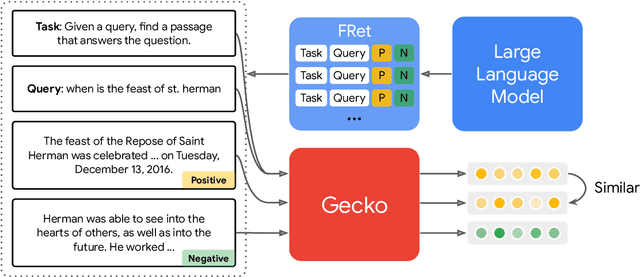


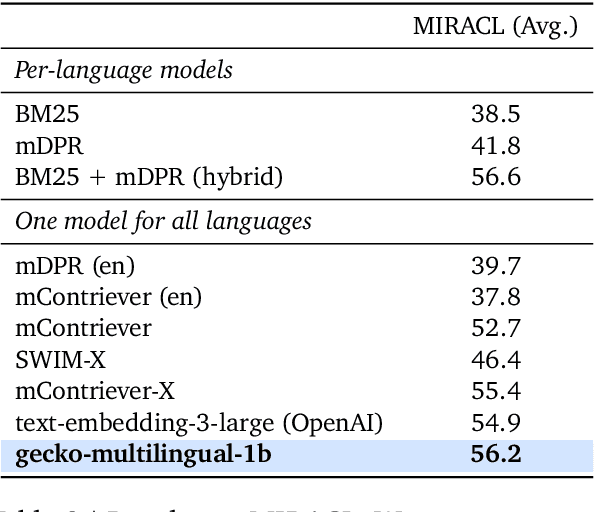
Abstract:We present Gecko, a compact and versatile text embedding model. Gecko achieves strong retrieval performance by leveraging a key idea: distilling knowledge from large language models (LLMs) into a retriever. Our two-step distillation process begins with generating diverse, synthetic paired data using an LLM. Next, we further refine the data quality by retrieving a set of candidate passages for each query, and relabeling the positive and hard negative passages using the same LLM. The effectiveness of our approach is demonstrated by the compactness of the Gecko. On the Massive Text Embedding Benchmark (MTEB), Gecko with 256 embedding dimensions outperforms all existing entries with 768 embedding size. Gecko with 768 embedding dimensions achieves an average score of 66.31, competing with 7x larger models and 5x higher dimensional embeddings.
Gemini: A Family of Highly Capable Multimodal Models
Dec 19, 2023Abstract:This report introduces a new family of multimodal models, Gemini, that exhibit remarkable capabilities across image, audio, video, and text understanding. The Gemini family consists of Ultra, Pro, and Nano sizes, suitable for applications ranging from complex reasoning tasks to on-device memory-constrained use-cases. Evaluation on a broad range of benchmarks shows that our most-capable Gemini Ultra model advances the state of the art in 30 of 32 of these benchmarks - notably being the first model to achieve human-expert performance on the well-studied exam benchmark MMLU, and improving the state of the art in every one of the 20 multimodal benchmarks we examined. We believe that the new capabilities of Gemini models in cross-modal reasoning and language understanding will enable a wide variety of use cases and we discuss our approach toward deploying them responsibly to users.
Rethinking the Role of Token Retrieval in Multi-Vector Retrieval
Apr 04, 2023Abstract:Multi-vector retrieval models such as ColBERT [Khattab and Zaharia, 2020] allow token-level interactions between queries and documents, and hence achieve state of the art on many information retrieval benchmarks. However, their non-linear scoring function cannot be scaled to millions of documents, necessitating a three-stage process for inference: retrieving initial candidates via token retrieval, accessing all token vectors, and scoring the initial candidate documents. The non-linear scoring function is applied over all token vectors of each candidate document, making the inference process complicated and slow. In this paper, we aim to simplify the multi-vector retrieval by rethinking the role of token retrieval. We present XTR, ConteXtualized Token Retriever, which introduces a simple, yet novel, objective function that encourages the model to retrieve the most important document tokens first. The improvement to token retrieval allows XTR to rank candidates only using the retrieved tokens rather than all tokens in the document, and enables a newly designed scoring stage that is two-to-three orders of magnitude cheaper than that of ColBERT. On the popular BEIR benchmark, XTR advances the state-of-the-art by 2.8 nDCG@10 without any distillation. Detailed analysis confirms our decision to revisit the token retrieval stage, as XTR demonstrates much better recall of the token retrieval stage compared to ColBERT.
Multi-Vector Retrieval as Sparse Alignment
Nov 02, 2022



Abstract:Multi-vector retrieval models improve over single-vector dual encoders on many information retrieval tasks. In this paper, we cast the multi-vector retrieval problem as sparse alignment between query and document tokens. We propose AligneR, a novel multi-vector retrieval model that learns sparsified pairwise alignments between query and document tokens (e.g. `dog' vs. `puppy') and per-token unary saliences reflecting their relative importance for retrieval. We show that controlling the sparsity of pairwise token alignments often brings significant performance gains. While most factoid questions focusing on a specific part of a document require a smaller number of alignments, others requiring a broader understanding of a document favor a larger number of alignments. Unary saliences, on the other hand, decide whether a token ever needs to be aligned with others for retrieval (e.g. `kind' from `kind of currency is used in new zealand}'). With sparsified unary saliences, we are able to prune a large number of query and document token vectors and improve the efficiency of multi-vector retrieval. We learn the sparse unary saliences with entropy-regularized linear programming, which outperforms other methods to achieve sparsity. In a zero-shot setting, AligneR scores 51.1 points nDCG@10, achieving a new retriever-only state-of-the-art on 13 tasks in the BEIR benchmark. In addition, adapting pairwise alignments with a few examples (<= 8) further improves the performance up to 15.7 points nDCG@10 for argument retrieval tasks. The unary saliences of AligneR helps us to keep only 20% of the document token representations with minimal performance loss. We further show that our model often produces interpretable alignments and significantly improves its performance when initialized from larger language models.
Bridging the Training-Inference Gap for Dense Phrase Retrieval
Oct 25, 2022Abstract:Building dense retrievers requires a series of standard procedures, including training and validating neural models and creating indexes for efficient search. However, these procedures are often misaligned in that training objectives do not exactly reflect the retrieval scenario at inference time. In this paper, we explore how the gap between training and inference in dense retrieval can be reduced, focusing on dense phrase retrieval (Lee et al., 2021) where billions of representations are indexed at inference. Since validating every dense retriever with a large-scale index is practically infeasible, we propose an efficient way of validating dense retrievers using a small subset of the entire corpus. This allows us to validate various training strategies including unifying contrastive loss terms and using hard negatives for phrase retrieval, which largely reduces the training-inference discrepancy. As a result, we improve top-1 phrase retrieval accuracy by 2~3 points and top-20 passage retrieval accuracy by 2~4 points for open-domain question answering. Our work urges modeling dense retrievers with careful consideration of training and inference via efficient validation while advancing phrase retrieval as a general solution for dense retrieval.
Refining Query Representations for Dense Retrieval at Test Time
May 25, 2022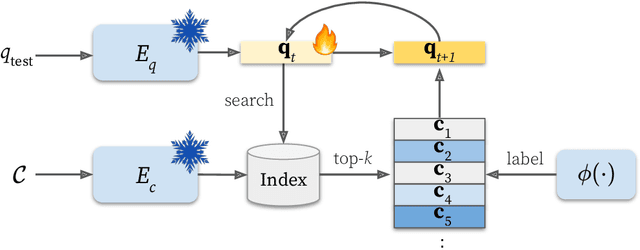
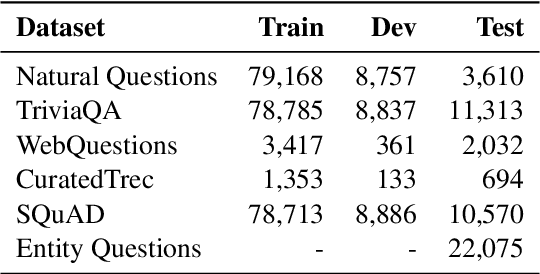
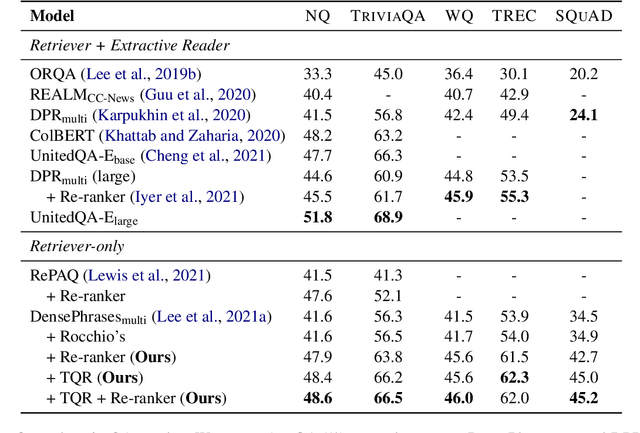
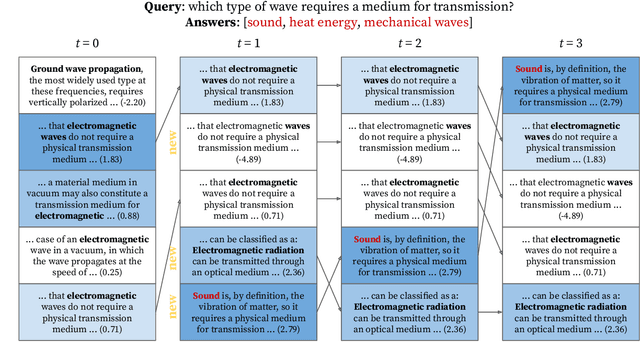
Abstract:Dense retrieval uses a contrastive learning framework to learn dense representations of queries and contexts. Trained encoders are directly used for each test query, but they often fail to accurately represent out-of-domain queries. In this paper, we introduce a framework that refines instance-level query representations at test time, with only the signals coming from the intermediate retrieval results. We optimize the query representation based on the retrieval result similar to pseudo relevance feedback (PRF) in information retrieval. Specifically, we adopt a cross-encoder labeler to provide pseudo labels over the retrieval result and iteratively refine the query representation with a gradient descent method, treating each test query as a single data point to train on. Our theoretical analysis reveals that our framework can be viewed as a generalization of the classical Rocchio's algorithm for PRF, which leads us to propose interesting variants of our method. We show that our test-time query refinement strategy improves the performance of phrase retrieval (+8.1% Acc@1) and passage retrieval (+3.7% Acc@20) for open-domain QA with large improvements on out-of-domain queries.
BERN2: an advanced neural biomedical named entity recognition and normalization tool
Jan 10, 2022

Abstract:In biomedical natural language processing, named entity recognition (NER) and named entity normalization (NEN) are key tasks that enable the automatic extraction of biomedical entities (e.g., diseases and chemicals) from the ever-growing biomedical literature. In this paper, we present BERN2 (Advanced Biomedical Entity Recognition and Normalization), a tool that improves the previous neural network-based NER tool (Kim et al., 2019) by employing a multi-task NER model and neural network-based NEN models to achieve much faster and more accurate inference. We hope that our tool can help annotate large-scale biomedical texts more accurately for various tasks such as biomedical knowledge graph construction.
 Add to Chrome
Add to Chrome Add to Firefox
Add to Firefox Add to Edge
Add to Edge